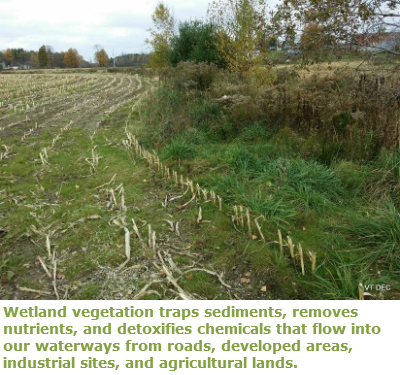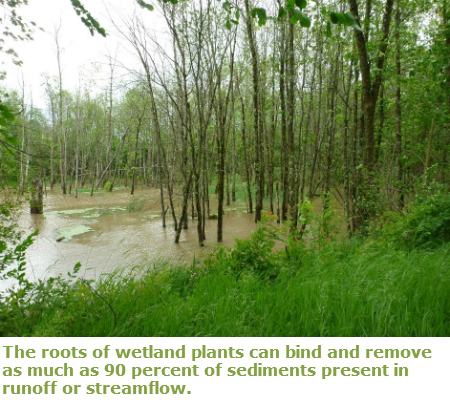 Many pollutants are washed by rainfall from urban and agricultural lands and are carried overland to water bodies. Pollutants include soil particles, fertilizers, pesticides, grease and oil from cars and trucks, and road salts. Wetlands can improve water quality by removing pollutants from surface waters. Three pollutant removal processes provided by wetlands are particularly important: sediment trapping, nutrient removal and chemical detoxification.
Many pollutants are washed by rainfall from urban and agricultural lands and are carried overland to water bodies. Pollutants include soil particles, fertilizers, pesticides, grease and oil from cars and trucks, and road salts. Wetlands can improve water quality by removing pollutants from surface waters. Three pollutant removal processes provided by wetlands are particularly important: sediment trapping, nutrient removal and chemical detoxification.
 As water from a stream channel or surface runoff enters a wetland, the water spreads out and flows through dense vegetation. The velocity of the flow is reduced, allowing suspended material in the water to settle to the wetland surface. The roots of wetland plants can then bind the accumulated sediments. As much as 90 percent of the sediments that are present in runoff or in streamflow may be removed if the water passes through wetlands. Also, because pollutants, such as heavy metals, are attached to soil particles, the settling of sediments in wetlands further improves water quality.
As water from a stream channel or surface runoff enters a wetland, the water spreads out and flows through dense vegetation. The velocity of the flow is reduced, allowing suspended material in the water to settle to the wetland surface. The roots of wetland plants can then bind the accumulated sediments. As much as 90 percent of the sediments that are present in runoff or in streamflow may be removed if the water passes through wetlands. Also, because pollutants, such as heavy metals, are attached to soil particles, the settling of sediments in wetlands further improves water quality.
 Nitrogen and phosphorus from agricultural and lawn fertilizers, pet waste, sewer and septic systems, and other sources can act as plant fertilizers in natural water bodies and stimulate excessive plant, algae, and cyanobacteria growth. Such growth may produce toxic chemicals and choke out natural vegetation and wildlife. When runoff and stream flow pass through wetlands before entering a water body, these nutrients may be taken up by wetland plants and accumulate in less harmful chemical forms. When wetland plants die and decay, nutrients are recycled within the wetland. Wetlands are so effective at removing excess nutrients from water that many municipalities have built wetlands specifically for treating effluent from secondary sewage treatment plants. Natural wetlands are not suited for this purpose and for each wetland there is a limit to how much can be added before the natural plant and chemical processes are overloaded and break down.
Nitrogen and phosphorus from agricultural and lawn fertilizers, pet waste, sewer and septic systems, and other sources can act as plant fertilizers in natural water bodies and stimulate excessive plant, algae, and cyanobacteria growth. Such growth may produce toxic chemicals and choke out natural vegetation and wildlife. When runoff and stream flow pass through wetlands before entering a water body, these nutrients may be taken up by wetland plants and accumulate in less harmful chemical forms. When wetland plants die and decay, nutrients are recycled within the wetland. Wetlands are so effective at removing excess nutrients from water that many municipalities have built wetlands specifically for treating effluent from secondary sewage treatment plants. Natural wetlands are not suited for this purpose and for each wetland there is a limit to how much can be added before the natural plant and chemical processes are overloaded and break down.
Some of the toxic chemicals carried into a wetland in runoff are trapped along with settled soil particles. Some of these pollutants may be buried in the sediments, while others may be converted into less harmful chemical forms by biological processes or by exposure to sunlight for extended periods. Still other pollutants may be taken up by the plants.
Some freshwater wetlands are located at points where surface water enters an underground aquifer, thereby recharging groundwater supplies. Wetlands are more often points of groundwater discharge to the surface of the land, such as springs. The groundwater discharge may be important as a local drinking water source or important for providing stream flows for fish, animals, plants, and other organisms that live on or near the stream during dry summer months.
According to the Vermont Wetland Rules, wetlands that make an important contribution to the protection or enhancement of the quality of surface or of ground water are significant wetlands. In determining whether a wetland is significant for the Surface and Ground Water Protection function,the Secretary or Panel shall, at a minimum, consider the extent to which it:
a. Recharges a drinking water source, such as a well head or source protection area.
b. Reduces levels of contaminants in surface waters which recharge underlying or adjacent groundwaters.
c. Contributes to the flows of Class A surface waters.
d. Enhances or protects water quality through chemical action, by the removal of nutrients, by the retention or removal of sediments or organic matter, or by moderating the adverse water quality effects of soil erosion or stormwater runoff.
e. Contributes to the protection or improvement of water quality of any impaired water.
f. Is adjacent to surface waters, especially impaired waters.
Links of Interest
- Wetlands and Water Quality: produced by Purdue University Cooperative Extension Service, this publication reviews the importance of wetlands to water quality, as well as some other functions.
- Clean Water Initiative: see what Vermont is doing with wetlands to help clean up the water in Lake Champlain.
